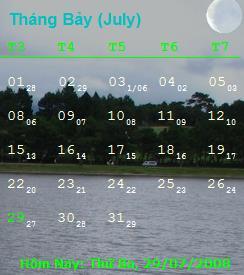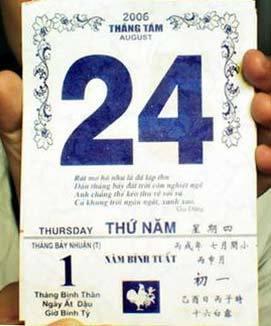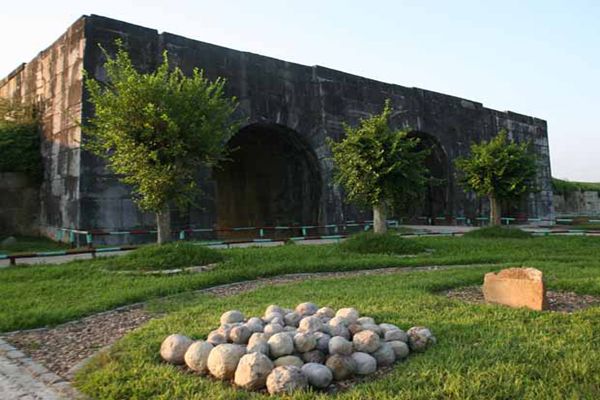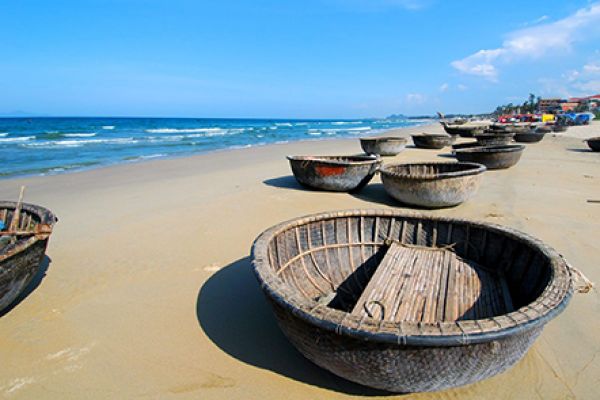Published: 00:00 Tuesday - January 06, 2009

Prior to adoption of the Western solar calendar system, the Vietnamese exclusively followed a lunar calendar in determining the times of planting, harvesting, and festival occasions.

Though today, people in Vietnam use the western calendar for most practical matters of daily life, the old system still serves as the basis for determining numerous seasonal holidays. This coexistence of two calendar systems has long been accepted by Vietnamese people. As with the Chinese, Vietnamese lunar calendar begins with the year 2637 B.C. It has 12 months of 29 or 30 days each, and the year totals 355 days.
A lunar month is determined by the period required for the moon to complete its full phasic cycle of 29 and a half days, a standard that makes the lunar year a full 11 days shorter than its solar counterpart. This difference is made up every 19 years by the addition of seven lunar months. The 12 lunar months are further divided into 24 solar divisions distinguished by the four seasons and times of heat and cold, all bearing close relationship to the yearly cycle of agricultural work.
Approximately every third year, an extra month is included between the third and fourth months. This is to reconcile the lunar calendar with the solar one.
Unlike our centuries of 100 years, the Vietnamese calendar is divided into 60-year periods called "Hoi". This "Hoi" or 60-year period is divided into two shorter cycles; one of a ten-year cycle and the other of a 12-year cycle.
The ten-cycle, called "Can" is composed of ten heavenly stems. Their names and approximate translation are as follows:
1. Giap water in nature
2. At water in the home
3. Binh lighted fire
4. Dinh latent fire
5. Mau wood of all types
6. Ky wood set to burn
7. Canh metal of all kinds
8. Tan wrought metal
9. Nham virgin land
10. Quy cultivated land
 The 12-year cycle, "Ky", has 12 earthy stems represented by the names os 12 names in the zodiac. Their names and translations in order are:
The 12-year cycle, "Ky", has 12 earthy stems represented by the names os 12 names in the zodiac. Their names and translations in order are:
1. Ty the rat
2. Suu the buffalo
3. Dan the tiger
4. Mao the cat
5. Thin the dragon
6. Ty the snake
7. Ngo the horse
8. Mui the goat
9. Than the monkey
10. Dau the cock (the chicken)
11. Tuat the dog
12. Hoi the pig
A Vietnamese year is named after the combination of one of the names of the ten heavenly stems and one of the names of the 12 earthly stems. For instance, 1964 was the Year of the Dragon, "Giap-Thin". Giap is the first of the ten-year cycles and Thin is the fifth of the 12-year cycle. The year 1965 was "At-Ty". This follows down the line each year. The ten-year stem is not usually mentioned when discussing the year. Thus, we hear "the Year of Dragon" or "the Year of Snake", etc. Giap-Thin, the Year of Dragon, will not return for a 60-year period. This is true of all combinations.
The Vietnamese like the lunar calendar because they can be sure of a full moon on the 15th day of each month. The lunar calendar can be quite precise and synchronized with the seasons so long as correct astronomical data are used.
More articles:










(84-63) 3 826042 – (84-63) 3 511142
No 54 Nguyen Dinh Chieu, Ham Tien Central Mui Ne Beach Binh Thuan Vietnam
523 To Hien Thanh District 10 Ho Chi Minh City Vietnam
Ha Long Halong City Quang Ninh Vietnam
A13 Hung Thong 2 Halong City Quang Ninh Vietnam




